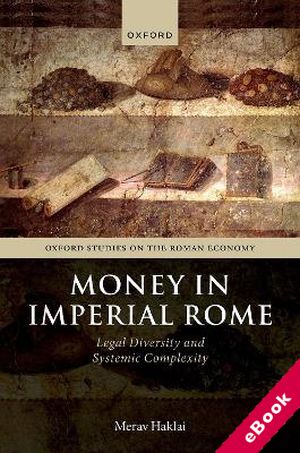
The device(s) you use to access the eBook content must be authorized with an Adobe ID before you download the product otherwise it will fail to register correctly.
For further information see https://www.wildy.com/ebook-formats
Once the order is confirmed an automated e-mail will be sent to you to allow you to download the eBook.
All eBooks are supplied firm sale and cannot be returned. If you believe there is a fault with your eBook then contact us on ebooks@wildy.com and we will help in resolving the issue. This does not affect your statutory rights.
Money in Imperial Rome offers an in-depth examination of the institutional framework within which money operated as an economic agent in the Roman empire, emphasising its systemic complexity. Analyses focus on classical Roman law as reflected in the writings of Roman jurists from the second and early-third centuries AD. The legal sources are augmented with documentary materials, which give independent evidence of actual practice, and with Jewish legal sources, which give evidence of a separate contemporary legal tradition. The work promotes Keynesian claims for the endogenous nature of money and adopts approaches advanced by new institutional economics (NIE), while its innovative contribution is in suggesting a complexity-oriented approach to understanding the conceptual framework that dictated the use of money in private transactions. Money is a complex phenomenon in the sense that it allows for new patterns of activity to be created by individuals, who adjust their use of it to the continuously evolving system in which they operate.
The book is divided into four parts. The first part is introductory. The second part traces a line of thought consistent in legal developments that regulated exchange, which perceived money as a unique phenomenon, different from all other items; therefore, specific rules were applied to money and a special role was allocated to it in defining the status of the parties. This is detectable for price (pretium) in the Roman contract for sale (emptio venditio), remuneration (merces) in the Roman contract for lease and hire (locatio conductio), and Jewish legal rules regarding sales conducted via a mode of acquisition known as 'acquisition by drawing' (qinyan meshikha). The third part examines money as a financial tool. It observes the various, innovative ways Romans used the instrument of interest. Then follows a discussion of regulations regarding interest-bearing deposits, its flexible application by individuals, and the interconnected dynamics within and between three legal traditions operating under Roman regime: Roman, Jewish, and Egyptian-Hellenistic laws. Investigation then moves to credit money in the Roman world and its capacity to increase the money supply. The fourth part offers a summary of the work and some conclusions.